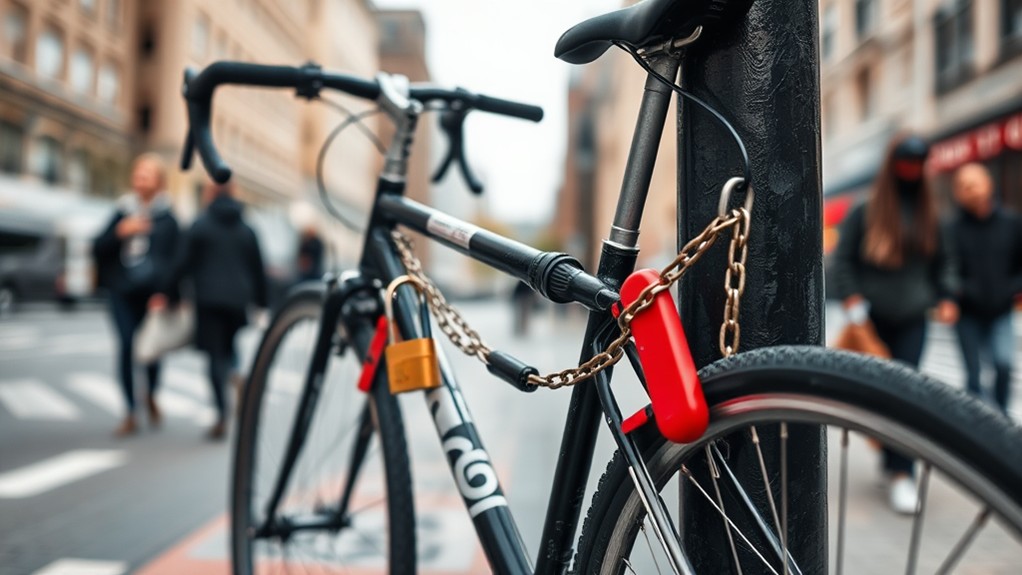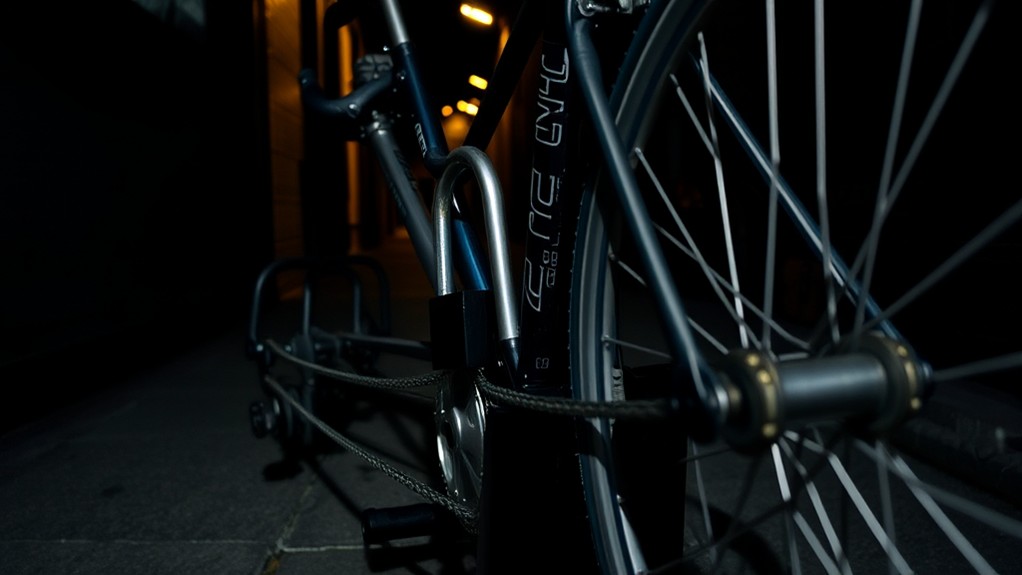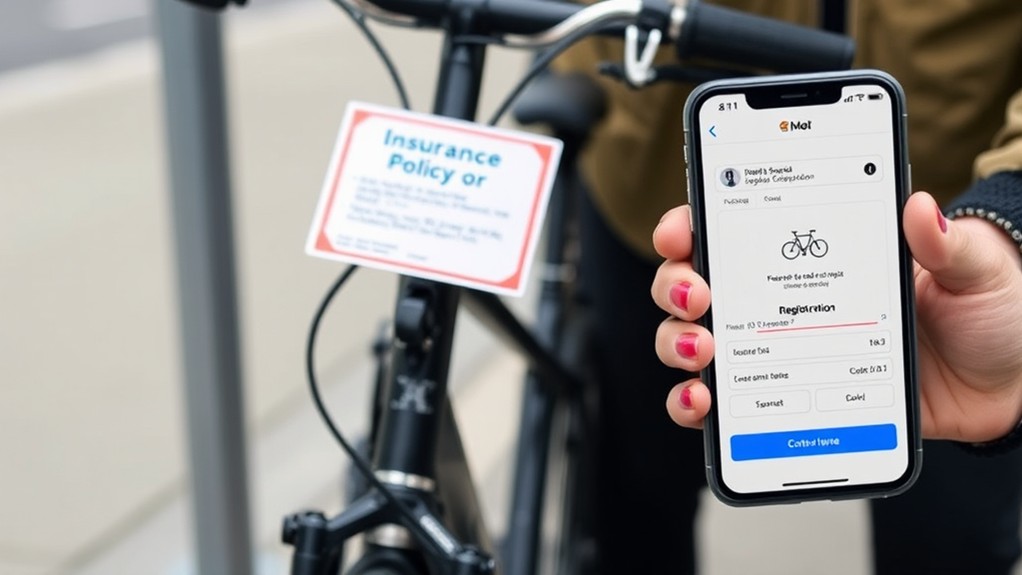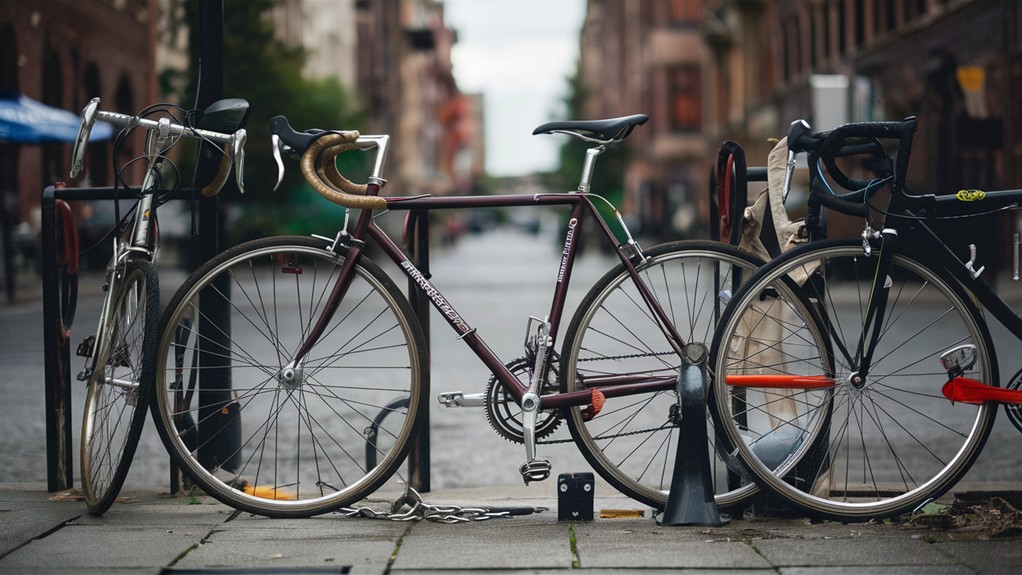When protecting your bike, you'll need a combination of temporary and permanent security measures. Temporary locks like U-locks, cable locks, and disc locks are suitable for short stops and should be attached to immovable objects in well-lit, busy areas. In contrast, permanent security solutions such as ground anchors, heavy-duty locks, and wall or floor-mounted anchor locks are ideal for securing your bike at home or in public areas with high foot traffic, deterring thieves with power tools. Understanding the differences between these two security approaches is key to effective bike protection, and learning the right techniques can further safeguard your investment.
Understanding Bike Theft Risks
The reality of bike theft is a concerning one – you're more likely to be a victim than you think.
Bike theft statistics are alarming, with approximately 290,000 bikes reported stolen in the UK alone in 2017, and an estimated 71% of thefts going unreported. This suggests a significant underestimation of the issue.
Understanding the risks is vital in developing effective bike security solutions. Urban vulnerabilities play a significant role in bike theft, with higher-value bikes being particularly attractive to thieves.
Key areas of vulnerability include:
- Urban areas with high foot traffic, where bikes are left unattended in public spaces
- Home locations, where half of all bike thefts occur, highlighting the need for secure indoor storage solutions
- Bikes worth over $200, which are more susceptible to theft because of their value
It is fundamental to acknowledge these risks to develop targeted strategies for securing your bike.
Choosing the Right Locks
Lock Types and Security Ratings
To guarantee effective protection, consider the following lock types and their security ratings:
- D-locks (U-locks): highly secure and lightweight, ideal for securing frames and wheels.
- Chain locks: offer added versatility and strength, suitable for different locking scenarios.
- Avoid using cable locks as primary security measures, as they're easily cut; instead, reserve them for alternative use, such as securing bike wheels.
When selecting a lock, look for Gold-rated locks, such as those certified by the Sold Secure scheme.
These locks are crucial for effective protection and may be required by insurance policies.
Temporary Security Measures

While stopping briefly, you can greatly reduce the risk of bike theft by using temporary security measures that complement your primary locking solution.
Consider utilizing lightweight locks, such as U-locks and cable locks, which are ideal for short stops. However, it's vital to combine these with more sturdy solutions for longer periods of unattended use.
To further improve security, employ portable devices like disc locks. According to statistics, bikes secured with disc locks are three times less likely to be stolen.
When using temporary locks:
- Always attach them to immovable objects in well-lit, busy areas to deter opportunistic theft.
- Consider using a supplementary lock, such as a chain lock, alongside a D-lock to secure both the frame and wheels.
Regular maintenance of temporary security devices is also important.
Verify that you regularly check and maintain the functionality of these devices to confirm they remain effective against theft.
Permanent Security Solutions
For maximum protection, consider investing in permanent bike security solutions that can greatly deter theft attempts. These solutions are designed to provide a strong and long-lasting layer of security for your bike.
Ground Anchors and Lock Durability
One vital component of permanent bike security is the use of ground anchors. These anchors are fixed to the ground and can withstand tampering, providing a secure attachment point for locks.
When choosing a lock to pair with your ground anchor, consider its durability. A heavy-duty lock and chain set with a minimum thickness of 16mm can markedly deter theft attempts, as they're resistant to power tool attacks.
Additional Security Measures
To further improve security, consider employing wall or floor-mounted anchor locks in garages or sheds. This is especially significant, as over half of bike thefts occur at home.
When selecting a lock, opt for a high-quality, Sold Secure Gold-rated lock, as many insurance policies require them for coverage against theft. Regular maintenance and inspection of your permanent security installations are likewise vital for ongoing effectiveness against theft.
Effective Locking Techniques

To improve your bike's security, it's vital to combine high-quality locks with effective locking techniques. While a good lock is significant, it's just as necessary to use it correctly.
Always lock both the frame and wheels to a solid, immovable object, filling as much of the D-lock as possible to minimize space for cutting tools and prying attempts.
Employing multiple locking strategies can also deter opportunistic theft. Consider pairing a D-lock with a cable lock to secure additional components or wheels. This redundancy can make a big difference in protecting your bike.
Some key locking strategies to keep in mind:
- Regularly check and maintain your locks to verify they're functioning properly and free of rust or debris, as a poorly maintained lock can be a weak point in your security.
- Pair a high-quality D-lock with a cable lock to secure wheels, seatposts, or other components.
- Educate yourself on local theft trends and adjust your locking techniques accordingly, such as opting for well-lit areas with CCTV coverage.
Securing Your Bike at Home
Home Storage Options
To improve bike security, consider the following home storage options:
- Use heavy-duty locks and ground anchors in garages or sheds to secure your bike.
- Remove or secure quick-release components to prevent opportunistic theft of wheels and other parts.
- Install battery-operated alarms to detect potential intruders.
- Use sturdy locks on storage areas to prevent unauthorized access.
Bike Registration and Insurance

In the matter of protecting your bike from theft, registering it and investing in dedicated insurance can be a game-changer.
Bike registration with schemes like the National Cycle Database or Immobilise greatly deters theft and assists in recovery efforts by providing proof of ownership.
Regarding insurance, you'll want to document your bike details, including the frame number and distinctive features, along with taking photographs, as this is crucial for reporting theft and filing insurance claims.
Some benefits of bike insurance include:
- Specialized bike insurance typically costs only a few pounds a month, offering better coverage than standard home insurance, especially for bikes stored away from home.
- Many insurers require the use of adequate locks for coverage, with some specifying that only Sold Secure Gold-rated locks will fulfill this requirement.
- Dedicated cycle insurance is often a more reliable option for higher-value bikes, as the average value covered by standard home insurance for bikes is around £300, which may not be sufficient.
Investing in dedicated bike insurance and registering your bike can provide peace of mind and protect your investment.
Preventing Theft in Public
While registering and insuring your bike can go a long way in protecting your investment, there are still steps you can take when leaving your bike unattended in public spaces.
Considering that over 40% of bike thefts occur when bikes are left unattended in public spaces, it's essential to take extra precautions. Effective theft deterrents include locking your bike in well-lit, busy areas with CCTV coverage. This notably reduces the risk of theft, as thieves are less likely to target visible bikes.
To enhance security, use high-quality locks, such as Sold Secure Gold-rated D-locks or chain locks. These locks can deter opportunistic thieves, as they often lack the tools to breach these secure options.
Furthermore, engage with local cycling communities to share tips and report suspicious activities, fostering community awareness and a safer environment for all cyclists.
Key Considerations:
- Check local theft statistics to identify high-risk zones
- Adjust parking and security measures accordingly
- Engage with local cycling communities to share tips and report suspicious activities
- Use high-quality locks, such as Sold Secure Gold-rated D-locks or chain locks.
Frequently Asked Questions
Can I Use a Permanent Anchor in a Rented Apartment?
You'll likely need permission from your landlord before installing permanent anchors in a rented apartment. Review your rental agreements to see if there are any restrictions on making permanent changes to the property.
Are Smart Locks Worth the Investment for Bike Security?
You're weighing the cost of smart locks for bike security. They offer features like GPS tracking and alerts, but drawbacks include higher prices, battery maintenance, and potential hacking risks – consider these factors before investing.
How Do I Transport a Heavy-Duty Bike Lock?
When transporting a heavy-duty bike lock, you're likely considering lock carrying and transport options. You can attach it to your bike, wear it on your body, or store it in a bag for easy transportation.
Can a Bike Be Secured to a Street Sign or Lamp Post?
You're considering securing your bike to a street sign or lamp post, but check local guidelines initially. Research street sign regulations and lamp post rules to avoid fines or removal of your bike.
Do Bike Insurance Policies Cover Locks and Accessories?
You should check if your bike insurance policy covers locks and accessories, as some policies may reimburse you for specific bike lock types. Review the terms to see what's included in your insurance coverage.
